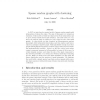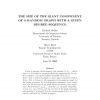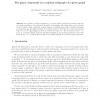126
click to vote
RSA
2011
14 years 7 months ago
2011
: The classical result in the theory of random graphs, proved by Erd˝os and Rényi in 1960, concerns the threshold for the appearance of the giant component in the random graph pr...
108
click to vote
RSA
2011
14 years 7 months ago
2011
In 2007 we introduced a general model of sparse random graphs with independence between the edges. The aim of this paper is to present an extension of this model in which the edge...
CPC
1998
15 years 12 days ago
1998
Given a sequence of non-negative real numbers 0 1 ::: which sum to 1, we consider a random graph having approximately in vertices of degree i. In 12] the authors essentially show ...
ALGORITHMICA
2007
15 years 25 days ago
2007
Two classic “phase transitions” in discrete mathematics are the emergence of a giant component in a random graph as the density of edges increases, and the transition of a rand...
107
click to vote
WAW
2009
Springer
15 years 7 months ago
2009
Springer
We consider a random subgraph Gp of a host graph G formed by retaining each edge of G with probability p. We address the question of determining the critical value p (as a function...
INFOCOM
2009
IEEE
15 years 7 months ago
2009
IEEE
—In this paper, we study the giant component, the largest component containing a non-vanishing fraction of nodes, in wireless multi-hop networks in d (d = 1, 2). We assume that n...



